We support our Publishers and Content Creators. You can view this story on their website by CLICKING HERE.
Key Points: The B-21 Raider stealth bomber program is advancing well, with the prototype flying twice weekly and two additional aircraft undergoing ground testing.
-Designed for nuclear and conventional payloads, the B-21 boasts cutting-edge stealth, a 6,000-mile range, and advanced software.
-It’s gaining praise for its potential to counter China’s defenses, with deployment slated at Ellsworth Air Force Base.
Despite its promising performance, costs remain a concern, ranging from $300 million to $750 million per unit.
-Experts recommend continued oversight, including reviews by Congressional agencies, to ensure the program avoids pitfalls.
B-21 Raider: The Stealth Bomber Changing the Game
I have told you about the U.S. Air Force’s trouble with the Next-Generation Air Dominance (NGAD) fighter in recent articles here at 19FortyFive.
There’s a pause on the program and the Air Force doesn’t know how much it is going to cost or how it will be designed.
But now consider the B-21 Raider stealth bomber and this news will put you in a better mood. The B-21 prototype is flying around twice a week with no reported hiccups.
Program Is Further Along Than Planned
The B-21 first took to the skies in November after ground testing and engine runs. Northrop Grumman built the stealth bomber in Palmdale, California, and a corporate executive for the defense contractor wants the B-21 to fly once a day. “If you think about how far ahead we are, that’s great,” said Tom Jones, president of Northrop’s aeronautics sector.
B-21 Raider: Push the Envelope
The Air Force and Northrop are testing different aspects of the B-21 while it’s in-air and are “expanding the operating envelope.” There is the main testing airplane, and two others are undergoing evaluations on the ground.
B-21 Raider. Image: Creative Commons.
The Air Force eventually want to acquire at least 100 B-21 Raiders. The stealth bomber is a dual-threat airplane that can deliver a nuclear payload or conventional munitions. Ellsworth Air Force Base in South Dakota will have the first squadron.
Local Senator Is Impressed
U.S. Senator Mike Rounds represents South Dakota and has become an expert on the B-21. Rounds is excited about the Raider and its potential use against China. He sounded off about the bomber at an event held by the Hudson Institute.
China May Never See the B-21 Until It’s Too Late
“When the B-21 enters the picture, this whole scenario changes. The B-21 is an aircraft that has been designed to be the most stealthy that the world has ever seen. They [China] do not have today the defensive capabilities to defend against it. It has long-range capabilities, which starts to take care of the problem that we have in the Pacific, in that today we don’t have the ability necessarily to get all the way into China with our most advanced weapon systems and to take out some of their critical infrastructure, their defensive capabilities, and their offensive capabilities. With the advent of the B-21, they have a long way to go. They have the ability to be refueled. They have the ability to loiter in the area and attack,” Rounds said.The B-21 has a range of 6,000 miles at a speed of 600 miles per hour. It is incredibly advanced with its updatable software and data processing. You could call it a flying computer.

Image: Creative Commons.
The air intakes are smaller and blended into the top surfaces of the bomber which reduces radar signature.
The B-21 is getting rave reviews, and it seems like a blockbuster, but the price tag may raise your eyebrows. Estimates vary on the cost but expect the Air Force to pay anywhere from $300 million to $750 million per bomber. Northrop Grumman says it will cost $550 million – not a bargain. In another estimate, the Air Force may pay $692 million in 2022 dollars.
Could It Cost As Much As the F-35?
Multiply that by 100, and you are talking about a price tag similar to the F-35, and that assumes no schedule slips or cost overruns. But so far, so good. Two flights a week at this juncture is impressive, and if the demonstrator and the two other birds can fly once a day, that would create a test and evaluation situation that the Air Force and Northrop Grumman would be proud of.
The B-21 Still Needs Government Oversight
Senator Rounds is a huge B-21 fan and sits on the Senate Armed Services Committee. If anything goes wrong with the stealth bomber, he will be the first to hear about it. If worse comes to worse, he can help hold a hearing and get to the bottom of any problems before they fester.
Get an Independent Review
I don’t see this program getting canceled anytime soon. However, I recommend that the Congressional Research Service and the Government Accountability Office write a fresh report on the B-21 after the test and evaluation have progressed to one flight per day – perhaps at the end of this year. This is the best and most independent way to watch the program. The biggest problem with the B-21 is the cost, and these government think tanks and watchdogs are the best equipped to provide an unbiased and objective truth about the program.
Let’s hope the Air Force and the defense contractor are not hiding B-21 wrinkles or warts in terms of unplanned additional costs.
About the Author: Dr. Brent M. Eastwood
Brent M. Eastwood, PhD, is the author of Don’t Turn Your Back On the World: a Conservative Foreign Policy and Humans, Machines, and Data: Future Trends in Warfare, plus two other books. Brent was the founder and CEO of a tech firm that predicted world events using artificial intelligence. He served as a legislative fellow for U.S. Senator Tim Scott and advised the senator on defense and foreign policy issues. He has taught at American University, George Washington University, and George Mason University. Brent is a former U.S. Army Infantry officer. He can be followed on X @BMEastwood.

 Conservative
Conservative  Search
Search Trending
Trending Current News
Current News 





